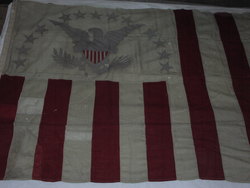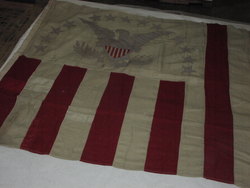


Canton +, Horizontal

Canton +

Canton

Oblique
US 13 Star, 16 Stripe, Revenue Cutter Ensign, 1894
Sub-collection: Mastai - Early American Flags13 Star U.S. Revenue Marine Ensign & Custom House Flag 1894.
The Act of March 2, 1799, known as the Customs Administration Act authorized that "the cutters and boats employed in the service of the revenue shall be distinguished from other vessels by "an ensign and pendant, with such marks thereon as shall be prescribed and directed by the President of the United States."
Oliver Wolcott, Alexander Hamilton's successor as Secretary of the Treasury in 1795, was given the honor of conceiving a new ensign. On June 1, 1799, Wolcott presented his design to President John Adams for approval. Wolcott's concept was an ensign of sixteen vertical stripes, alternating red and white, corresponding to the number of states comprising the Union by 1799. Wolcott was following the stipulations of Congress, which, in 1794, had already modified the national flag to fifteen stars on fifteen stripes, providing for an amendment to the design at the entry of each new state. Wolcott increased the stripes to sixteen, and altered their display to be perpendicular to the horizontal lines of the U.S. Flag.
This new flag was ultimately implemented August 1, 1799, when Secretary of the Treasury, Oliver Wolcott, issued an order announcing that in pursuance of authority from the President, the distinguishing ensign and pennant would consist of, "16 perpendicular stripes, alternate red and white, the union of the ensign to be the arms of the United States in a dark blue on a white field."
Although Secretary Wolcott created a service-wide design it was the responsibility of each collector of customs to make local arrangements for the furnishing revenue cutter ensigns and though conceived as a maritime ensign for revenue cutters and customs vessels, the customs officials began flying it over their customhouses. Because of the locally produced variants there would be no standardization in the manufacture and issue of this flag until the American Civil War.
During the Civil War, the Treasury Department began standardizing Revenue Marine ensigns. In 1874, Treasury Secretary William A. Richardson stipulated that during business hours, the customs ensign would be flown alongside the Stars and Stripes at all customhouses. This particular flag is thought to date from the same period.
This wool bunting and cotton applique flag is machine sewn, utilizing a zigzag stitch not generally found in flag manufacture until after 1893. This flag is believed to date from that period.
Exhibition History:
Special Memorial Day Display
Suspended from ceiling of Moraga Room.
Presidio of San Franciscos Officers Club
Memorial Day 2003
Chicago Meeting December, 2003
(ZFC0671)
13-Star United States Revenue Cutter Ensign
Baltimore Star Spangled Banner Flag House 3/2004
(ZFC0671)
U.S. Revenue Cutter Ensign
American Maritime Flags of the 19th Century
ZFC Significant Flag
Provenance:
• Acquired by Mr. & Mrs. Boleslaw & Marie-Louise D'Otrange Mastai, New York City, and Amagansett, NY, The Mastai Collection, until 2002.
• Sold via Sotheby's Auction in New York City to the Zaricor Flag Collection, 2002.
Sources:
Madaus, Howard M.- Whitney Smith, The American Flag: Two Centuries of Concord and Conflict, VZ Publications, Santa Cruz, 2006.
Mastai, Boleslaw and Marie-Louise D'Otrange, The Stars and The Stripes: The American Flag as Art and as History from the Birth of the republic to the Present, Knopf, New York, 1973.
Preble, George Henry, The History of the Flag of the United States of America, Boston, Houghton, Mifflin & Co. 1894.
Saba, Anne, January 2000, Tradition, Service, Honor - The Customs Ensign, Customs Today, 1 November 2011, from:
http://www.cbp.gov/custoday/jan2000/tradtn.htm
Flag Day: CBP's Ensign Was America's First For Government Agency, 1 November 2011, http://www.cbp.gov/xp/cgov/newsroom/highlights/flag_day.xml
United States Customs Service. Wikipedia, 1 November 2011, from:
http://en.wikipedia.org/wiki/United_States_Customs_Service
Flags, Logos, Pennants, Seals & Streamers Of the Coast Guard & Its Predecessor Services, United states Coast Guard, 1 November 2011, from:
http://www.uscg.mil/history/articles/Coast_Guard_Flags.asp
Image Credits:
Zaricor Flag Collection.
Hoist & Fly | |
|---|---|
| Width of Hoist | 70.5 |
| Length of Fly | 119 |
Union/Canton | |
|---|---|
| Width of Union/Canton | 36 |
| Length of Union/Canton | 58.5 |
Stars | |
|---|---|
| Size of Stars | 5 |
Stripes | |
|---|---|
| Size of Hoist | 2 |
Frame | |
|---|---|
| Is it framed? | no |
Stars | |
|---|---|
| Number of Stars | 13 |
| How are the stars embeded? | Machine Stitched |
| Are there stars on obverse? | yes |
| Are there stars on reverse? | yes |
| Star Pattern | 4-5-4 in an arc ofer the eagle |
| Star Field Design |
|
Stripes | |
|---|---|
| Number of Stripes | 16 |
| Color of Top Stripe | Red |
| Color of Bottom Stripe | White |
| Has a Blood Stripe? | no |
| Comments on Stripes | Red stripe 7". White stripe 8". |
Crest/Emblem | |
|---|---|
| Description of Crest/Emblem | Coat of Arms of the United States. |
Nationality | |
|---|---|
| Nation Represented | United States |
Fabric | |
|---|---|
| Fabric | Wool |
| Comments on Fabric | Wool bunting with cotton eagle and stars. Bunting |
Stitching | |
|---|---|
| Stitching | Machine |
| Comments on Stitching | Straight stitch for stripes, zig-zag stars and eagle. |
Weave | |
|---|---|
| Type of Weave | Plain |
Attachment | |
|---|---|
| Method of Attachment | Grommets |
Applica | |
|---|---|
| Applique Sides | Single Faced = Mirror Image Reverse |
Condition | |
|---|---|
| Condition | Fair |
| Damage | Used Trending to good |
| Displayable | yes |
Date | |
|---|---|
| Date | 1893 |
Exhibits | |
|---|---|
| Exhibition Copy | Special Memorial Day Display Suspended from ceiling of Moraga Room. Presidio of San Franciscos Officers Club Memorial Day 2003 13-Star, 16-Stripe United States Revenue Cutter Ensign Date: Circa 1895-1915 Comment: This ensign, first adopted in 1799, remained unchanged for 116 years to become the longest-lived Unites States flag design. Because this flag incorporated what was a new innovation at the time(a sewing device to affix its stars with zig-zag stitching), it can be dated from the end of the Revenue Service's era. In 1915 the service was combined with the Lighthouse Service. With the addition of its own special emblem on the stripes, the same basic flag continues in use today as the ensign of the U.S. Coast Guard. (ZFC0671) Chicago Meeting December, 2003 (ZFC0671) 13-Star United States Revenue Cutter Ensign Date: 1870-1880 Medium: Wool bunting Oliver Wolcott, Alexander Hamilton's successor as Secretary of the Treasury in 1795, was given the honor of conceiving a new ensign. On June 1, 1799, Wolcott presented his design to President John Adams for approval. Wolcott's concept was an ensign of sixteen vertical stripes, alternating red and white, corresponding to the number of states comprising the Union by 1799. Wolcott was following the stipulations of Congress, which, in 1794, had already modified the national flag to fifteen stars on fifteen stripes, providing for an amendment to the design at the entry of each new state. Wolcott increased the stripes to sixteen, and altered their display to be perpendicular to the horizontal lines of the U.S. Flag. This new flag was ultimately implemented August 1, 1799, when Secretary of the Treasury, Oliver Wolcott, issued an order announcing that in pursuance of authority from the President, the distinguishing ensign and pennant would consist of, "16 perpendicular stripes, alternate red and white, the union of the ensign to be the arms of the United States in a dark blue on a white field." Although Secretary Wolcott created a service-wide design it was the responsibility of each collector of customs to make local arrangements for the furnishing revenue cutter ensigns and though conceived as a maritime ensign for revenue cutters and customs vessels, the customs officials began flying it over their customhouses. Because of the locally produced variants there would be no standardization in the manufacture and issue of this flag until the American Civil War. Provenance: Acquired by the Zaricor Flag Collection (ZFC0671) from the Mastai Collection in October 2002. Baltimore Star Spangled Banner Flag House 3/2004 (ZFC0671) U.S. Revenue Cutter Ensign Date: about 1890-1895 Media: Wool bunting field and canton with cotton stars and arms, machine sewn. Size: 70.5" on the hoist by 119" on the fly (6' by 10') Comment: Because the ensign of the U.S. Revenue Cutter Service and the U.S. Customs Service has not been substantially changed in its design for 205 years, dating the flags of these agencies is usually effected by studying subtle differences in construction techniques. This flag is machine sewn (thus postdating 1850). More noticeably, its stars are appliquéd by a zigzag machine stitching technique. The zigzag attachment was invented near the end of the American Civil War, but its use in flag production is doubtful before 1893. The configuration of the eagle in the U.S. coat-of-arms also is a datable device for Revenue Cutter Service flags. Early illustrations of Revenue Cutter Service flags appeared in the 1868 and 1882 versions of the Navys Flags of Maritime Nations and depict the coat-of-arms with down-turned wings. The upraised wing configuration of the U.S. coat-of-arms on the Revenue Cutter Service flag does not appear until the 1899 edition of that manual. It does appear in that configuration, however, in the 1882 editions depiction of the Presidents flag, which makes it difficult for historians and vexillologists to date the flag with precision. Provenance: Acquired in 2002 by the Zaricor Flag Collection from the Mastai Collection through auction at Sotheby's of New York, New York. American Maritime Flags of the 19th Century Government vessels, private ships and coastal installations all call for flags that can be recognized from great distances and in inclement weather. This was achieved during the nineteenth century by providing such craft and structures with flags that were particularly large. Exhibited here are several American flags related to such vessels or facilities from 1818 to 1893. All are large bunting flags. Generally speaking, a large flag is one that is too unwieldy to be carried by one person if the flag is attached to a staff. Until 1854 in the British Army, and 1895 in the American Army, military colors carried by units on foot were made of silk and measured no more than 6 feet on the staff by 6 feet 6 inches on the fly. Those dimensions encompassed slightly more than four square yards of cloth and were considered the maximum size for transport by an individual with staff. Most of the flags in this exhibit exceed those parameters. Due to their size, large flags such as these are difficult to display and are seldom sought by collectors. Museums often relegate them to storage. This exhibit is unusual, therefore, in that it displays so many of these flags in one place. This exhibit is sponsored by the Veninga-Zaricor family and Good Earth Teas, Santa Cruz, CA; The Flag Center, Presidio of San Francisco, CA; and the Star-Spangled Banner Flag House, Baltimore, MD. |
Publications | |
|---|---|
| Flag Books | |












